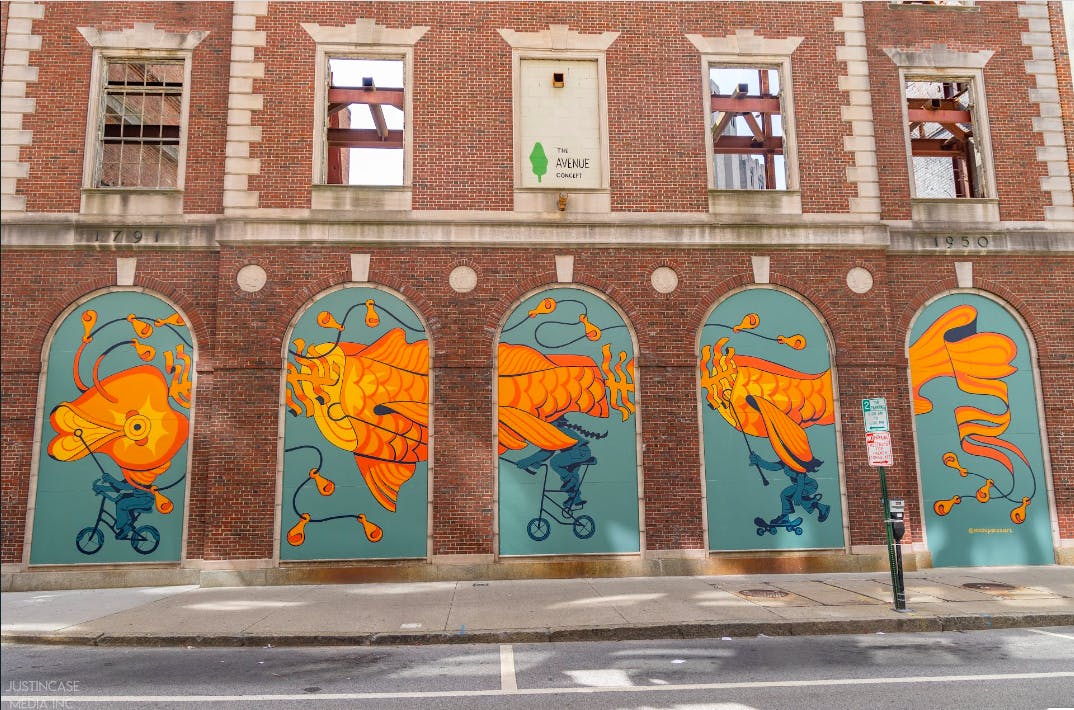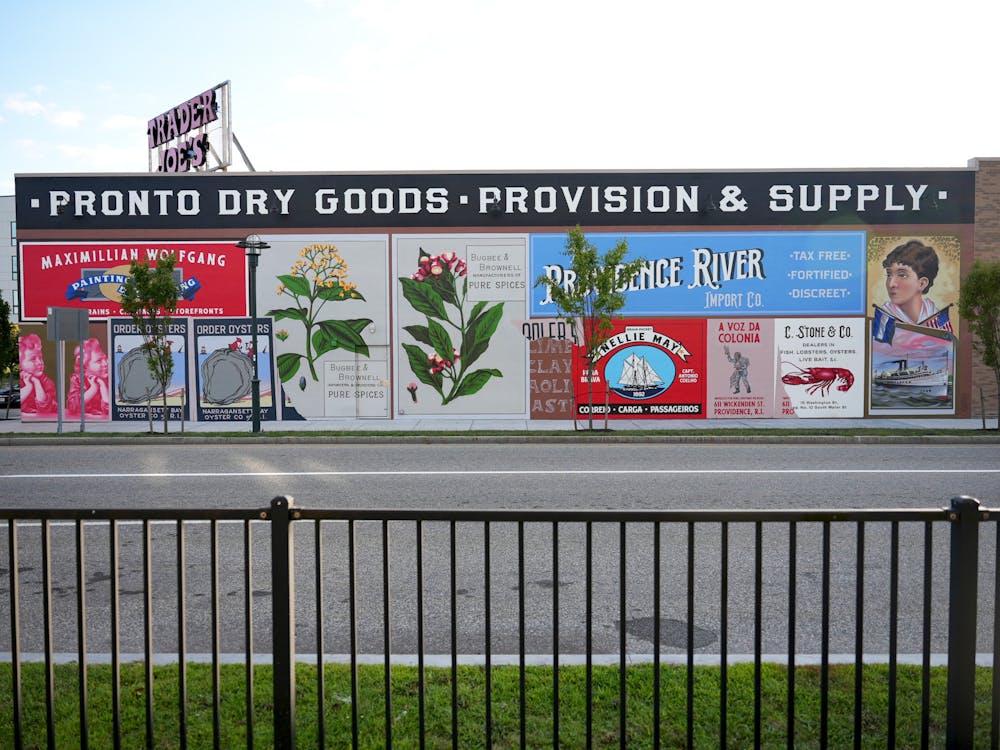Artist Greg Pennisten, known professionally as Greg Was Here, credits his childhood love of art to Robert Wyland, a conservationist famous for his life-size whale murals.
“That piqued my interest in art in a more public sense,” Pennisten said, “the fact that there are commercial artists making art for slightly different purposes, but art that was equally as valid and interesting and beautiful in its own right.”
Greg Pennisten doesn’t paint whales. But he did paint the entire side of a building.
Sprawled across the facade of Trader Joe’s, Pennisten’s mural on South Main Street, titled “Confluence,” collages 19th-century Providence signage as a nod to the city’s river trade history. The mural’s upper corner reads “Providence River Import Co,” framed by graphics referencing historical Providence industries. Pennisten calls it “hyper-local” — it’s a culmination of his time spent researching and reimagining local historical advertisements.
“Confluence” was one of thirteen public art installations introduced by The Avenue Concept, an organization that works to support the creation and installation of public art, this year. Founded in 2012, the nonprofit has since developed numerous projects to celebrate public art in Providence. Their hallmark mural and sculpture programs, which feature works from local artists, can be found throughout the streets and alleyways of Providence. Some of these installations have become iconic mainstays: The “Still Here” mural by Gaia, for example, celebrated its fifth year anniversary last month.
“The Avenue Concept has produced over 250 public artworks and experiences,” Tamara Patton, TAC’s development and communications manager, wrote in an email to The Herald on behalf of the organization’s team. “Undervalued but widely encountered spaces could be transformed into vibrant places through art, design and community connectivity.”
Pennisten considers public art a relatively new phenomenon, that “was not always as important as it is now,” he said. Big cities like Los Angeles and Philadelphia “latched onto the idea of public art early on,” but smaller cities are just starting to engage with the art style.
Joe Wilson Jr., director of Providence’s Department of Art, Culture and Tourism, which collaborates closely with TAC, attributes Providence’s growth in public art to the city’s creative “synergy,” informed by its vibrant college communities, rich diversity and accessibility.
“Providence is an extraordinarily dynamic city,” Wilson said. “This state was established as a place for people who could find no home anywhere else … public art is just another piece to telling that story.”
Storytelling is also a central mission for Michelle Perez, a Providence-based illustrator and designer. Her mural “Parade,” located on Weybosset Street, is a fantastical reimagining of Providence summers, bikers and WaterFire.

Courtesy of The Avenue Concept
Raised on eclectic family anecdotes, Perez describes learning about her Venezuelan culture and family members as “mythical or folkloric,” connecting with them as “those stories are passed down,” she explained.
Her mural is a love letter to the whimsical aspects of Providence: A bright orange fish lantern, carried by bikers and skaters, stretches across the sidewalk against a turquoise backsplash. It’s a reference to the fish lanterns used during Waterfire, which she jokingly likens to a “Viking funeral.”
“Parade” is also imbued with movement and rhythm, a tribute to the bustling bikers and skaters that traverse Providence’s roads in the summer. “I was just thinking about … the way (Providence) slowly comes back to life after being so dormant during the really cold months,” she said.
Lydia Musco, a New England-based artist, hopes to create a similar impact with her sculpture “Twelfth Unconformity,” located on the corner of Empire and Fountain streets. “I’ve always thought about art as something that you come across and it’s a surprise, … a color on some flowers, a sign that’s askew,” she explained. “It takes you out of your head for a moment and puts you in the present.”
The daughter of a poet and a woodworker, Musco was taught to pay attention to the structural quirks of natural landscapes — how environments decay and rebuild over time. Her sculptures, which encapsulate the light and color of a New England February through layers of mold-casted concrete, reflect this process. “I build them from the ground up … and once they’re completed, they get broken down again,” said Musco.
She finds the melding of urban and natural architecture particularly compelling. Framed by angular, straight lines of sidewalks and crossroads, the graphic elements of her sculpture stand out against its environment. “That spot in particular is pretty great because it's a corner,” she explained, “so you can approach it from pretty much all directions. … There’s so many different ways to see it.”

“We're leaning into new ways to lead, execute and provide opportunities for the next generation of arts leaders,” Yarrow Thorne, founder and executive director of TAC, wrote in an email to The Herald. “We're deepening relationships with organizations and individuals to give voice to what, who and how art is made in neighborhoods.”
As an actor and director, Wilson said he believes that public art is a necessary part of Providence’s fabric that needs to be protected, an effort organizations like TAC have been pioneers in. “If we don’t invest more in our Creative Capital, we may lose it,” he said.
Megan is a metro editor covering health and environment. Born and raised in Hong Kong, she spends her free time drinking coffee and wishing she was Meg Ryan in a Nora Ephron movie.





